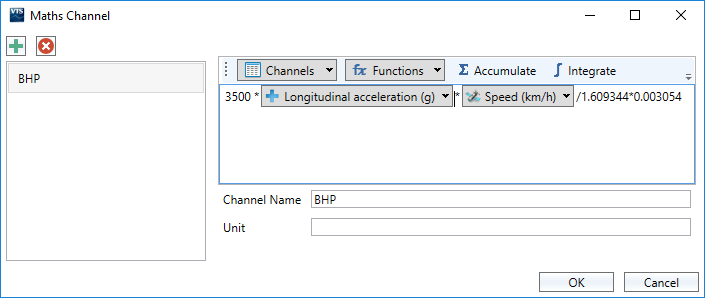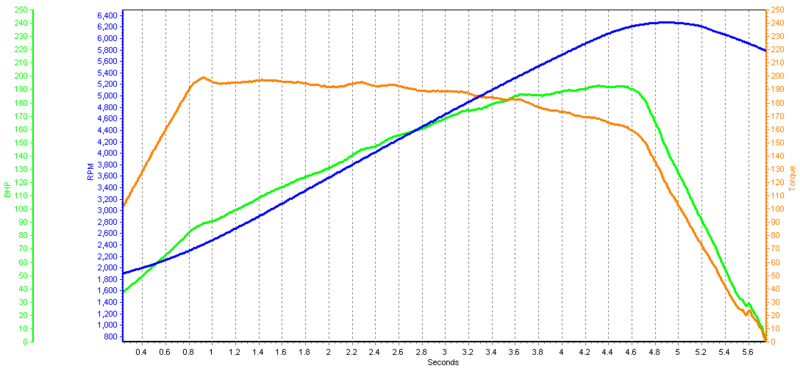Power, Torque and RPM Calculations
VBOX Test Suite and VBOX Tools Software have the ability to calculate BHP at the wheels using any Racelogic VBOX Data Logger that can record speed and longitudinal acceleration. To get the most accurate results, it is imperative that:
- An accurate vehicle weight value is entered - this must include the weight of the vehicle as well as fuel, occupants, and baggage. If possible, getting a weight reading from vehicle weigh pads is the best option.
- The test location is ideal - a clear, open, level road is used to capture test data.
Requirements to ensure the consistent accurate results
- Open test area: No trees, buildings or bridges nearby.
- A clear, open, level road is used.
- In the chosen gear, accelerate hard from low RPM towards the top of the rev range.
- Open logged file in VBOX Test Suite or VBOX Tools.
Calculating Power
VBOX Test Suite
- Load the logged file into VBOX Test Suite and open the Test Setup tab.
- Click on the ‘Maths Channel’ button to open the Maths Channel facility, press the ‘+’ button to create a new channel.
- Enter one the following equations. For this to be as accurate as possible, you will need to know the kerb weight of the vehicle and add the weight of anything else that might be in the vehicle (driver, fuel, etc…).
- Click the ‘OK' button to apply the calculation.
- In the 'Chart' tab, select the new channel from the X or Y-axis so that it can be viewed in the Chart area.
To calculate BHP enter the following equation:
Weight (lbs) * Longitudinal acceleration (g) * Speed (km/h) / 1.609344 * 0.003054
To calculate kW enter the following equation:
Weight (kg) * Longitudinal acceleration (g) * Speed (km/h) * 0.0031107

An example BHP calculation in VBOX Test Suite
VBOX Tools
- Load the logged file into VBOX Tools and open the Graph screen facility in order to view the logged file.
- Click on the ‘Generate New Channel’ button to open the maths channel facility.
- Enter one the following equations. For this to be as accurate as possible, you will need to know the kerb weight of the vehicle and add the weight of anything else that might be in the vehicle (driver, fuel, etc…).
- Click the ‘Generate Channel’ button to apply the calculation, and then close the Maths channel setup window.
- Tick the new Power channel so that it can be viewed in the Graph screen.
To calculate BHP enter the following equation:
Weight (lbs) * LongAcc (g) * Speed channel (mph) * 0.003054
To calculate kW enter the following equation:
Weight (kg) * LongAcc (g) * Speed channel (km/h) * 0.0031107

An example BHP calculation in VBOX Tools
RPM Calculation
If RPM has not been measured and logged in the VBOX file, the following guide can be used to generate an RPM channel. This theory is only applicable because the power accel test is only in one gear.
- Drive the test vehicle in the chosen acceleration gear and make a note of the exact speed at an exact RPM point, i.e. 54 km/h at 3000 RPM.
- Divide the RPM value by the Speed value i.e. 3000/54 = 55.56, this creates you a 'Speed to RPM conversion ratio'.
- Create a RPM channel using the Generate (maths) channel facility in the Graph Screen, Speed x 'Speed to RPM conversion ratio',
- You will now have an RPM channel that you can view in the graph screen.
Note: It will only be correct for the vehicle when the car is in the chosen acceleration gear.
Torque Calculation
To calculate torque, you will need to have calculated the power of the vehicle and RPM. If you do not have the RPM figure, it can be generated in VBOX Test Suite or VBOX Tools using Maths Channels, as detailed below.
To calculate Torque in Nm, create a new Maths Channel and enter the following equation:
Power (kW) * 9549 / rotational speed (rpm)
To calculate Torque in ft-lb, create a new Maths Channel and enter the following equation:
Power (hp) * 5252 / rotational speed (rpm)

